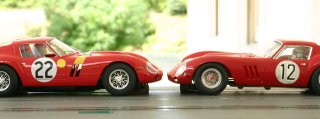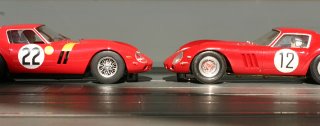
The new Fly Ferrari 250 GTO is one of their best, with fine detail, smooth finish, and great lines. There are delicate grilles beneath the transparent hood scoops, true to the actual cars. Hood latches are photo etched. Yellow discs were placed on the doors of this car at Le Mans, 1962, to alert rescue crews to the aluminum bodywork.

The Fly GTO compares well to the old standard Revell GTO, grandfather to the Pink Kar version. Fly model is better detailed, shows better curves, but has minor errors.

From the rear, the Fly car shows more curvaceous lines, in keeping with the timeless Ferrari design. Old Revell tail lights look better when painted, though. Fly tail lights resemble LEDs poking through the body.

From the side, Fly scores again with full body lines and deeper side panels, but nose-high attitude of Fly is evident.

To drop the nose of the body, nearly 1/16" is trimmed from the two front (red plastic) body posts, and the same amount is removed from the headlight crossbar mounts (black plastic). Without lowering the headlight crossbar, the nose cannot drop. A clearance hole for the rear drive shaft bearing is cut between the seats, and the floor of the interior pan is cut away. The underside of the seats are filed to allow the body and interior to settle down onto the chassis. A slab of lead is taped under the rear deck to help the 70 gram car hook up a little better on the wood track. The guide is shimmed .030" to bring it deeper into the slot. These changes make the car driveable without its magnet.

With body lowered, the Fly car compares favorably to the older car. Now the front wheels are where they belong in the arches.

Rear tires measure a full 12" wide. The actual '62 GTO's had tires no more than 9 inches wide (7.00x15 size). Even the front tires are too wide for the rear. Although this error is not apparent from the side, it is anachronistic, and just plain wrong for the car. These fat tires belong on a 1967 or later car; the markings on this Ferrari are of an actual 1962 Le Mans contestant.

Replacement wheels by BWA, custom turned with a dropped center to take Ortmann repro Monogram rear tires (correct scale size) are lined up for eventual use on the Fly car. And I should point out that the plastic Fly axle bearings are a good fit on the axle, with almost no slop.

Another Revell GTO, with rocker panels extended slightly downward, and reworked side vents fore and aft, shows off its BWA wheels, Ortmann tires, and BWA inserts. These are a better representation of the actual GTO wheels and tires than the Fly wheels and tires.
No model is perfect, but the Fly Ferrari GTO is a fine model, and can be easily corrected in minor ways to be even better.
4 comments:
It sure is nice to hear that Fly got the body right. I was worried this car might be too much of a "racing body".
The racing potential of this car remains to be developed. The body is fairly thin and light, unlike some earlier Fly Classics. I still have not tuned this car for speed; I'm thinking Slot.it gears, rear axle, and bearings may be the best route. The Fly gear seems crude, with excessive side play due to the width of the locator groove in the gear hub. And of course, BWA wheels/inserts with Ortmann tires will be installed. The front stub axles are pretty floppy, and could be redone somehow. I would like to leave the front motor as-is; with enough weight near the rear axle, front motor cars can be made to handle on wood, no-mag.
I am now tryiong to get the Ferrari to go fast. That is very difficult! I have added lead low in the chassis, at the rear, so the car now weighs 80 grams, and is very slightly weight-biased toward the rear. It still deslots from time to time, when the rear tires start chattering. At least they grip somewhat. I have rounded the outside shoulders and trued them with sandpaper, which seems to help. I have freed up the body to float a little, but it is still fairly well clamped to the chassis by the screws, even when they are backed off a turn. The screw holes need to be bigger. I have equalled the best lap time of the MMK Maserati 151, another "standard Mabuchi" powered car . . . but still one of the slowest cars in the stable!
How many of this car still exist and who owns them? Wonder how much one of this would cost nowadays. They are just wonderful.
Post a Comment